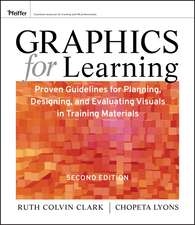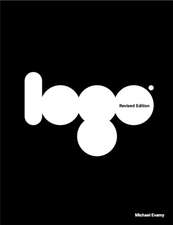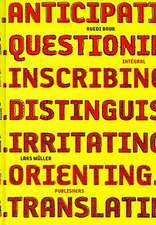Design Thinking for Visual Communication: Basics Design
Autor Gavin Ambroseen Limba Engleză Paperback – 11 sep 2019
Preț: 167.71 lei
Preț vechi: 193.54 lei
-13% Nou
Puncte Express: 252
Preț estimativ în valută:
32.09€ • 33.51$ • 26.50£
32.09€ • 33.51$ • 26.50£
Carte disponibilă
Livrare economică 26 martie-09 aprilie
Livrare express 11-15 martie pentru 54.76 lei
Preluare comenzi: 021 569.72.76
Specificații
ISBN-13: 9781350106222
ISBN-10: 1350106224
Pagini: 192
Ilustrații: 200 colour illus
Dimensiuni: 160 x 230 x 19 mm
Greutate: 0.43 kg
Editura: Bloomsbury Publishing
Colecția Bloomsbury Visual Arts
Seria Basics Design
Locul publicării:London, United Kingdom
ISBN-10: 1350106224
Pagini: 192
Ilustrații: 200 colour illus
Dimensiuni: 160 x 230 x 19 mm
Greutate: 0.43 kg
Editura: Bloomsbury Publishing
Colecția Bloomsbury Visual Arts
Seria Basics Design
Locul publicării:London, United Kingdom
Caracteristici
Includes Industry View interviews in each chapter from leading design studios such as NB Studio, Design is Play, Second Story and others
Notă biografică
Gavin Ambrose teaches at Brighton University, UK. He is a graphic designer, and author and designer of books on branding, packaging, and editorial design.Paul Harris is a freelance writer and journalist who specalises in design. He is the co-author of numerous books with Gavin Ambrose.
Cuprins
IntroductionChapter one: Stages of ThinkingThe design process; Stage one - Define; Stage two - Research; Stage three - Ideate; Stage four - Prototype; Stage five - Select; Stage six - Implement; Stage seven - Learn; Industry view: NB Studio. Chapter two: ResearchIdentifying drivers; Information gathering; Target groups; Samples and feedback; Industry view: Tanner Christensen.Chapter three: Idea GenerationBasic design directions; Questions and answers; Themes of thinking; Inspiration and references; Brainstorming; Value; Inclusion; Sketching; Industry view: Planning Unit.Chapter four: RefinementThinking in images; Thinking in signs; Appropriation; Humor; Personification; Visual metaphors; Modification; Thinking in words; Type 'faces'; Thinking in shapes; Thinking in color; Thinking in technology; Industry view: Lavernia & CienfuegosChapter five: PrototypingDeveloping designs; 'Types' of prototype; Vocabulary; What do do if you get stuck; Industry view: Second Story.Chapter six: ImplementationFormat; Materials; Finishing; Media; Scale; Series/Continuity; Industry view: Design is Play.ExercisesGlossaryIndex
Recenzii
'I have adopted this book. It provides a great structure for this course which has a variety of students from design, advertising and illustration programs.'
'Beautifully designed and filled with excellent examples.'
'The format and design of the book is very good for getting the information across ... the diagrams and images are extremely helpful in explaining the concepts.'
'I like this book, as well as the others books in this series, because of the excellent examples of designs to illustrate the text. The design is clear, and makes the book easy to use. The different paper stocks not only help with orientation, but provide great examples of when to do this. A great addition to the Basics series.'
Packed with examples from students and professionals and fully illustrated with clear diagrams and inspiring imagery, Design Thinking for Visual Communication offers an essential exploration of design thinking. The new 2nd edition now includes contributions from a broader international range of design practices and adds depth to existing case studies by looking in greater detail at some of the processes used.
'Beautifully designed and filled with excellent examples.'
'The format and design of the book is very good for getting the information across ... the diagrams and images are extremely helpful in explaining the concepts.'
'I like this book, as well as the others books in this series, because of the excellent examples of designs to illustrate the text. The design is clear, and makes the book easy to use. The different paper stocks not only help with orientation, but provide great examples of when to do this. A great addition to the Basics series.'
Packed with examples from students and professionals and fully illustrated with clear diagrams and inspiring imagery, Design Thinking for Visual Communication offers an essential exploration of design thinking. The new 2nd edition now includes contributions from a broader international range of design practices and adds depth to existing case studies by looking in greater detail at some of the processes used.















